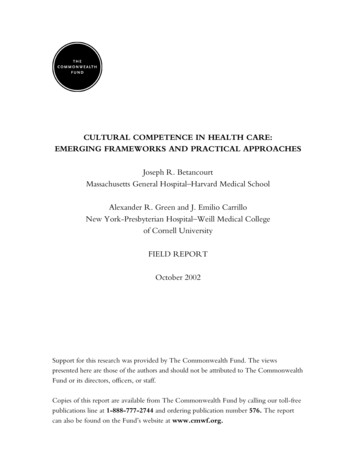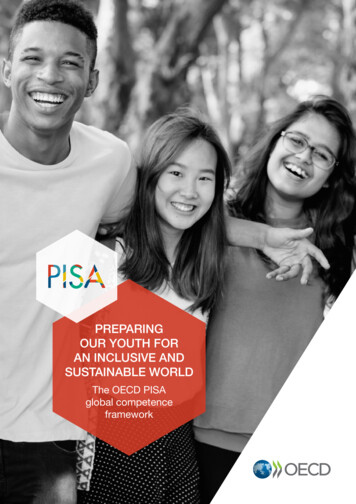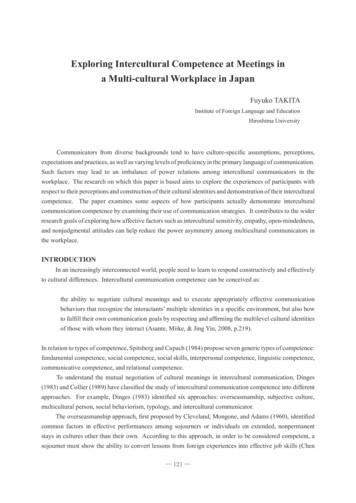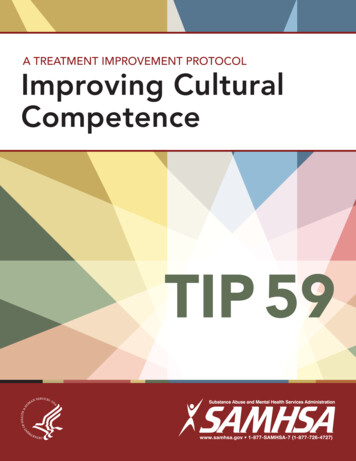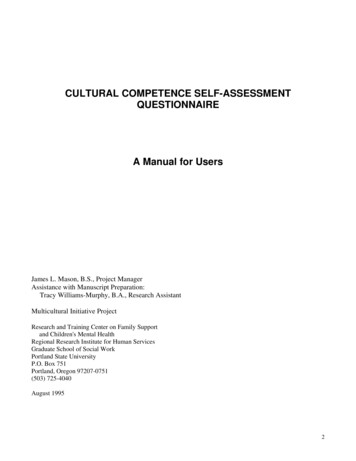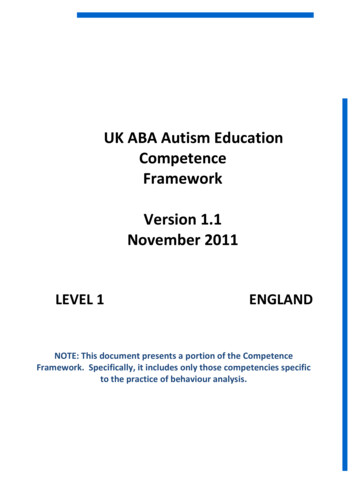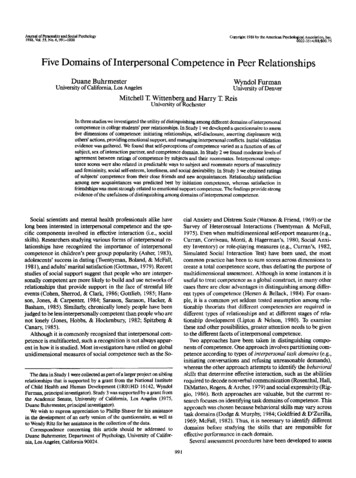
Transcription
Cultural Competence and CulturalSafety: A Knowledge TranslationSymposiumCourtyard by Marriott Downtown Toronto HotelMonday, March 19th, 2012 andTuesday, March 20th,2012
WelcomeBienvenue
Special thanks to the Aboriginal HealthHuman Resource Initiative, First Nations andInuit Health Branch for funding this project,and
Learning from Previous Initiativesof Cultural Competence andCultural SafetySylvia Barton, RN, PhD, University of AlbertaCathy Graham, RN, MSc, Trent/ Fleming School of NursingJane Moseley, RN, BScN, MAdEd, St. Francis Xavier UniversityWanda Pierson, RN, BSN, MSN, PhD, Langara CollegeTerry Penny, RN, BScN, MSN, Nova Scotia Community College
St. Francis XavierSchool of NursingAntigonish, Nova ScotiaJane Moseley, RN, BScN, MAdEdSt. Francis Xavier University
Invest in nursing faculty supply and nursing program infrastructureFoster innovative initiatives to sustain an appropriately prepared nursing workforceInvest in nursing research and knowledge translationWorkshop ‘Integrate Cultural Competencyand Cultural Safety into Curriculum’March 12, 2012 Workshop jointly developed by:Nova Scotia Community College, School ofHealth and Human ServicesSchool of Nursing, St. Francis XavierUniversity
Invest in nursing faculty supply and nursing program infrastructureFoster innovative initiatives to sustain an appropriately prepared nursing workforceInvest in nursing research and knowledge translationWorkshop Key Note SpeakerLisa Perley-Dutcher,UNB Panel DiscussionJeff Orr & JoanneTompkins, Education,StFXU Two-Eyed SeeingAlbert Marshall, CherylBartlett, MurdenaMarshall IntegratedScience Program, CapeBreton University
Identified areas to work on forstudent retention and completion ofprogramsInvest in nursing faculty supply and nursing program infrastructureFoster innovative initiatives to sustain an appropriately prepared nursing workforceInvest in nursing research and knowledge translationOUTCOME from ParticipantWorking Groups:
Invest in nursing faculty supply and nursing program infrastructureFoster innovative initiatives to sustain an appropriately prepared nursing workforceInvest in nursing research and knowledge translationStudent Retention Support diverse ways of knowing otherthan books and exams: diverseknowledge, ways of knowing, learningand teaching – this should be reflectedin policies re: learning styles andexams Hire Aboriginal faculty & staff
Invest in nursing faculty supply and nursing program infrastructureFoster innovative initiatives to sustain an appropriately prepared nursing workforceInvest in nursing research and knowledge translationStudent Retention Build strong relationships withcommunities / elders Value traditional healing and knowledgeas legitimate, what health means forAboriginal peoples, and methods oftreatment Acknowledge biases – address biaseswith policy changes
Invest in nursing faculty supply and nursing program infrastructureFoster innovative initiatives to sustain an appropriately prepared nursing workforceInvest in nursing research and knowledge translationStudent Retention Professors/teachers need to understand,critically assess and self-reflect - postcolonial, colonization, cultural safety,indigenous knowledge, spirituality Faculty, staff & student education for selfreflection, critical assessment, evaluation andmodification of unequal power structures thatexist in academia and healthcare
Understand and appreciate thatculture is situated in the broadersocio-economic, political andhistorical contextsInvest in nursing faculty supply and nursing program infrastructureFoster innovative initiatives to sustain an appropriately prepared nursing workforceInvest in nursing research and knowledge translationStudent Retention
Invest in nursing faculty supply and nursing program infrastructureFoster innovative initiatives to sustain an appropriately prepared nursing workforceInvest in nursing research and knowledge translationSuccessful Completion Ensure support for Aboriginal students– safe environments & smaller groups,financial, childcare, tutors, studybuddy, flexibility Strong Aboriginal student advisoroffice – know resources and availablecommunity members
Invest in nursing faculty supply and nursing program infrastructureFoster innovative initiatives to sustain an appropriately prepared nursing workforceInvest in nursing research and knowledge translationSuccessful Completion Incorporate A.N.A.C. CoreCompetencies into all levels of nursingcurriculum – weave Mi’Kmaq culturethroughout the curriculum – AboriginalAdvisors or elders should validate whatis presented Identify and address barriers faced byAboriginal students
Aboriginal nursing students will beunderstood & appreciated for theirways of knowing and doingInvest in nursing faculty supply and nursing program infrastructureFoster innovative initiatives to sustain an appropriately prepared nursing workforceInvest in nursing research and knowledge translationSuccessful Completion Maintain relationships with Aboriginalcommunities
Invest in nursing faculty supply and nursing program infrastructureFoster innovative initiatives to sustain an appropriately prepared nursing workforceInvest in nursing research and knowledge translationLessons learned thus far Journey: a continuous learning & buildingjourneyRelationships: Community AdvisoryCommittee, students (Mentorship), advisorGuiding Principles: Respect for Indigenouscultural integrity; Relevance to First Nations,Inuit and Métis Perspectives and Experience;Reciprocal Relationships; Responsibilitythrough Participation (A.N.A.C., 2009. P. 18)
Invest in nursing faculty supply and nursing program infrastructureFoster innovative initiatives to sustain an appropriately prepared nursing workforceInvest in nursing research and knowledge translationLessons learnedTwo-Eyed Seeing – Reflective (LessonsLearned) from Albert Marshall, MurdenaMarshall, Cheryl Bartlett - Integrative ScienceProgram, Cape Breton University.Ways of knowing (learning) - holistic learningmodel (medicine wheel); Holistic LifelongLearning Model, the learning spirit (CanadianCouncil for Learning)
Anti-racist education (St. Denis, 2007).Deconstruct history - unsettle thesettler – history of colonization and theimpact on indigenous peoples (Regan,2011)Invest in nursing faculty supply and nursing program infrastructureFoster innovative initiatives to sustain an appropriately prepared nursing workforceInvest in nursing research and knowledge translationLessons learned
Relational – ‘deeply reflective practice isat the core of relational culturalcompetence’(Hanson, 2009).Invest in nursing faculty supply and nursing program infrastructureFoster innovative initiatives to sustain an appropriately prepared nursing workforceInvest in nursing research and knowledge translationLessons learned Personal relationship with IK andpeople – self-discovery
Cross-cultural bridge building;Becoming an ally (Bishop, 2002) Political – transfer into social actionand policy (Prosper, McMillan, Davis, &Moffitt, 2011)Invest in nursing faculty supply and nursing program infrastructureFoster innovative initiatives to sustain an appropriately prepared nursing workforceInvest in nursing research and knowledge translationLessons learned
Invest in nursing faculty supply and nursing program infrastructureFoster innovative initiatives to sustain an appropriately prepared nursing workforceInvest in nursing research and knowledge translationLessons learned Partnership with academia andcommunity Committee for Aboriginaland Black Student Success (CABSS,2006) – influence academia throughcommunity partnerships, applied forproject through, Canada Research Chairfor Indigenous Studies and SustainableCommunities, Aboriginal Health HumanResource Initiatives
Invest in nursing faculty supply and nursing program infrastructureFoster innovative initiatives to sustain an appropriately prepared nursing workforceInvest in nursing research and knowledge translationLessons learned Identify School of Nursing responsibilitiesand roles Responsibility of ANNSO andSchool of Nursing Responsibility of Aboriginal StudentAdvisor (Student Services) Responsibility of University(Distance Education, etc.)
Invest in nursing faculty supply and nursing program infrastructureFoster innovative initiatives to sustain an appropriately prepared nursing workforceInvest in nursing research and knowledge translationNext Steps Complete UCR grant – pilot researchproject by Dec 2012 Resource binders Dedicated faculty/staff curriculum dayswith expert and Indigenous eldersand/or advisors Continue to look for funding forIndigenous enrichment strategy
Invest in nursing faculty supply and nursing program infrastructureFoster innovative initiatives to sustain an appropriately prepared nursing workforceInvest in nursing research and knowledge translationConversations with Dr. Maria Battiste, Spring 2011 Medicine Wheel directions (Mi’Kmaq colors)proceed West, North, East, SouthNORTHhistory of colonization-Treaties, wledgeSOUTHlearners attitudesnon-Aboriginal & AboriginalJ Moseley March 2012
Invest in nursing faculty supply and nursing program infrastructureFoster innovative initiatives to sustain an appropriately prepared nursing workforceInvest in nursing research and knowledge translationReferencesSummary of Lessons Learned and References.1. Relationships with First Nations, Inuit and Metis peoples, community, elders, keystakeholders. Guiding Principles to enhance nursing curriculum: Respect for Indigenouscultural integrity; Relevance to First Nations, Inuit and Metis Perspectives and Experience;Reciprocal Relationships; Responsibility through Participation (ANAC, 2009. P. 18) Aboriginal Nurses Association of Canada. (2009). Cultural competence & cultural safetyin First Nations, Inuit and Metis nursing education: An integrated review of theliterature. Ottawa: ANAC. Battiste, M. & Henderson, J. Y.(Sa’ke’j). (2009). Naturalizing Indigenous knowledge inEurocentric Education. Canadian Journal of Native Education, 32(1), 5-18. Hanson, G. (2009). A relational approach to cultural competence in restoring thebalance, (Chapter 9) in First Nation Women, Community, and Culture, Editors GailValaskakis, Madeleine Dion Stout, and Eric Guimond. University of Manitoba,Winninpeg: University of Manitoba Press. Orchard, C. A., Disham, P. Jong, c., & Fry, J. (2010). Integrated nursing access program:An approach to prepare Aboriginal students for nursing careers. International Journalof Nursing Education Scholarship, 7(1). Art. 10. DOI:10.2202/1548-923X.1777
Invest in nursing faculty supply and nursing program infrastructureFoster innovative initiatives to sustain an appropriately prepared nursing workforceInvest in nursing research and knowledge translationReferences Con’t2. Two-Eyed Seeing – Reflective (Lessons Learned) from the Integrative Science Program, CapeBreton University Hatcher A.M., Bartlett, C.M., Marshall, A., & Marshall, M. (2009). Two-Eyed Seeing inthe classroom environment: Concepts, approaches, and challenges. Canadian Journalof Science, Mathematics, and technology education, 9(3): 141-153. Battiste, M. & Youngblood Henderson, J. (Sa’ke’j). (2009). Naturalizing Indigenousknowledge in Eurocentric Education. Canadian Journal of Native Education, 32(1), 5-18. Iwama, M., Marshall, M., Marshall, A., & Bartlett, C. (2009). Two-Eyed seeing and thelanguage of healing in community-based research. Canadian Journal of NativeEducation, 32(2), 3-23.3. Ways of knowing (learning) - wholistic learning model (medicine wheel); Holistic LifelongLearning Model, the learning spirit (Canadian Council on Learning). Association of Canadian Deans of Education. (2010). Accord on Indigenous Education. Canadian Council on Learning & Aboriginal Learning Knowledge Centre (2007). FirstNations Holistic Lifelong Learning Model. Saskatoon: University of Saskatchewan. Battiste, Mariah. (2011). Nurturing the future: Exploring maternal health knowledge,attitudes and behaviors among Mi’kmaw women. Unpublished thesis. Saskatoon:University of Saskatchewan. Anuk, J., Battiste, M., & George, P. Ningwakee (2010). Learning from promisingprograms and application in nourishing the learning spirit. Canadian Journal of NativeEducation, 33(1), 63-82. Battiste, M. & Henderson, J. Y.(Sa’ke’j). (2009). Naturalizing Indigenous knowledge inEurocentric Education. Canadian Journal of Native Education, 32(1), 5-18. Hanson, G. (2009). A relational approach to cultural competence in restoring thebalance, (Chapter 9) in First Nation Women, Community, and Culture, Editors GailValaskakis, Madeleine Dion Stout, and Eric Guimond. University of Manitoba,Winninpeg: University of Manitoba Press.
Invest in nursing faculty supply and nursing program infrastructureFoster innovative initiatives to sustain an appropriately prepared nursing workforceInvest in nursing research and knowledge translationReferences Con’t4. Anti-racist education St. Denis, V. (2007). Aboriginal education and anti-racist education: Building alliancesacross cultural and racial identity. Canadian Journal of Education, 30(4), 1068-1092. Bishop, A. (2002). Becoming an ally: Breaking the cycle of oppression. (2nd edition).Toronto: University of Toronto Press. McGibbon, E., & Etowa, J. (2009). Anti-racist health care practice. Toronto: Women’sPress.5. Deconstruct history - unsettle the settler – history of colonization and the impact onindigenous peoples National Aboriginal Health Organization (31 January 2006). Fact Sheet: Cultural Safety. Regan, P. (2010). Unsettling the settler within: Indian residential schools, truth telling,and reconciliation in Canada. Vancouver: University of British Columbia Press.6. Relational – “deeply reflective practice is at the core of relational cultural competence” Hanson, G. (2009). A relational approach to cultural competence. In Restoring thebalance: First Nations women, community and culture, Gail Guthrie Valaskakis,Madeleine Dion Stout, and Eric Guimond, Editors. Winnipeg, Manitoba: University ofManitoba Press.7. personal relationship with IK and peoples– self-discovery National Aboriginal Health Organization (31 January 2006). Fact Sheet: Cultural Safety.
Invest in nursing faculty supply and nursing program infrastructureFoster innovative initiatives to sustain an appropriately prepared nursing workforceInvest in nursing research and knowledge translationReferences Con’t8. Cross-cultural bridge building; building ally – transforms attitudes, imbedded in nursingpractice St. Denis, V. (2007). Aboriginal education and anti-racist education: Building alliancesacross cultural and racial identity. Canadian Journal of Education, 30(4), 1068-1092. Bishop, A. (2002). Becoming an ally: Breaking the cycle of oppression in people . (2ndedition)Toronto: University of Toronto Press. Hampton, M.J., & Hampton, A. (2010). The feather effect: Understanding thearchitecture of cross-cultural bridge building. Google books http://books.google.com/ St. Denis, V. (2010). A study of Aboriginal teachers’ professional knowledge andexperience in Canadian schools. Canadian Teachers’ Federation & Canadian Council onLearning.9. political – transfer into social action and policy Prosper, K., McMillan, L.J., Davis, A.A., & Moffitt, M. (2011). Returning to Netukulimk:Mi’kmaq cultural and spiritual connections with resource stewardship and selfgovernance. The international Indigenous Policy journal, 2(4). Retrieved fromhtp:llir.lib.uwo.ca/iipj/vol2/iss4/7 Fonda, M. (2011). Introductory essay: Traditional knowledge, spirituality and lands. Theinternational Indigenous Policy journal, 2(4). Retrieved fromhtp:llir.lib.uwo.ca/iipj/vol2/iss4/7 Fonda, M. (2011). Introductory essay: Traditional knowledge, spirituality and lands. TheInternational Indigenous Policy Journal, 2(4). Retrieved fromhttp://ir.lib.uwo.ca/iipj/vol2/iss4/1
School of Nursing, St. Francis Xavier . Marshall Integrated Science Program, Cape Breton University . ure on OUTCOME from Participant Working Groups: Identified areas to work on for student retention and completion of programs . ure on Student Retention Support diverse ways of knowing other



